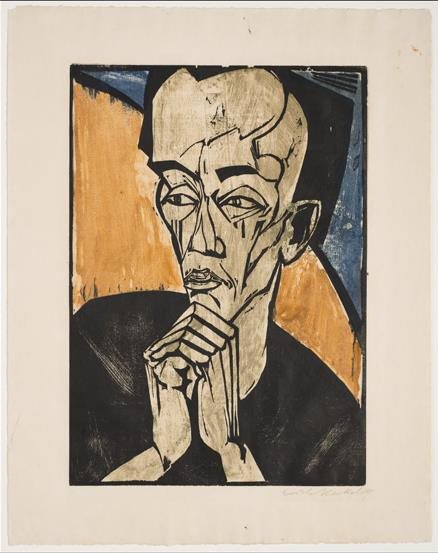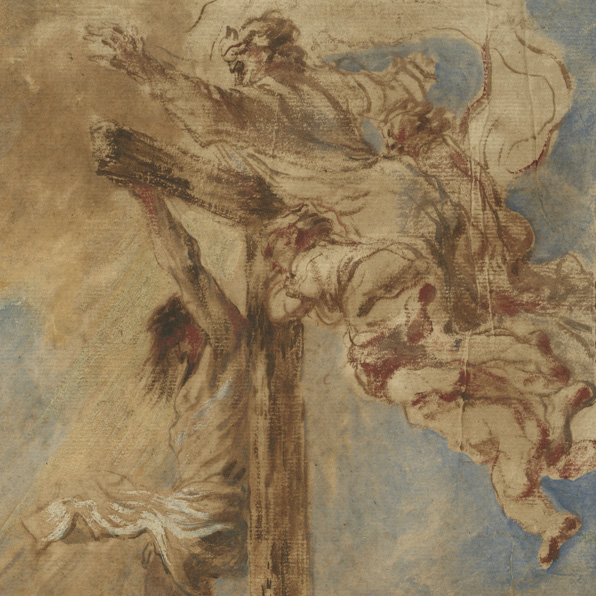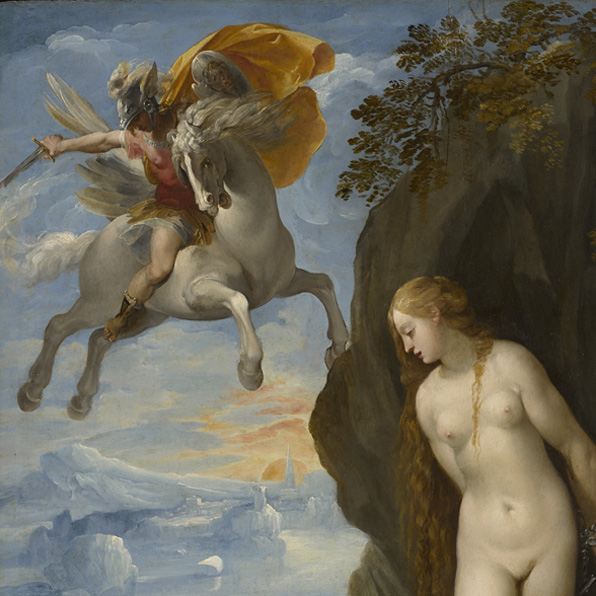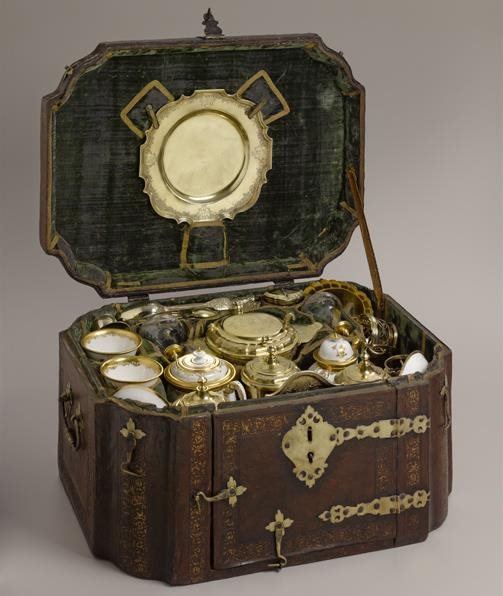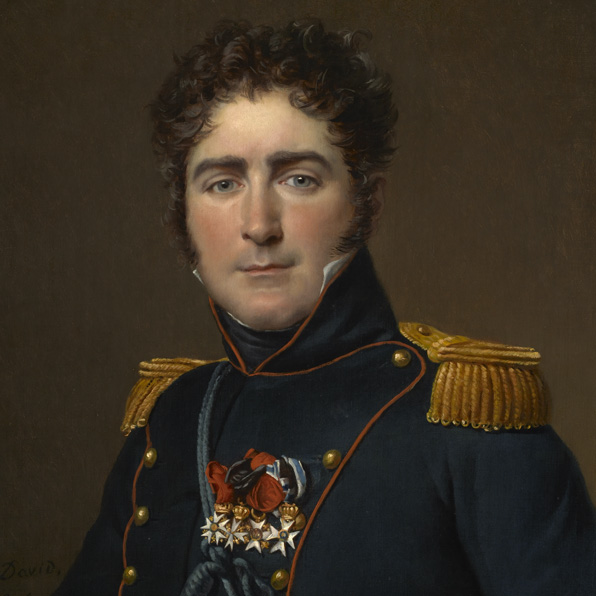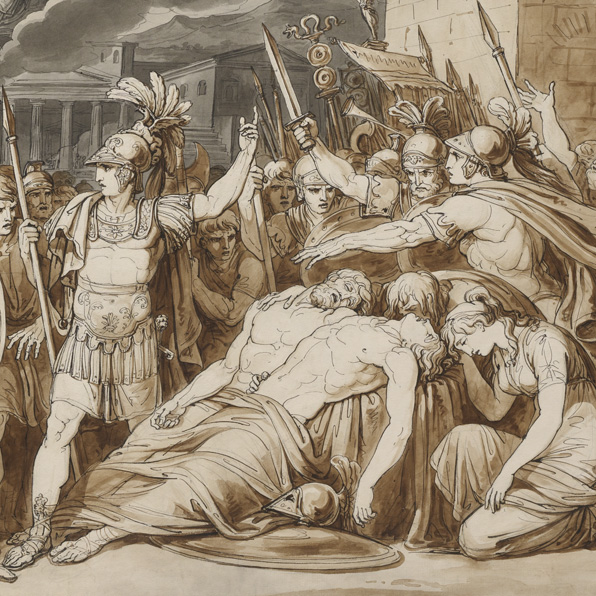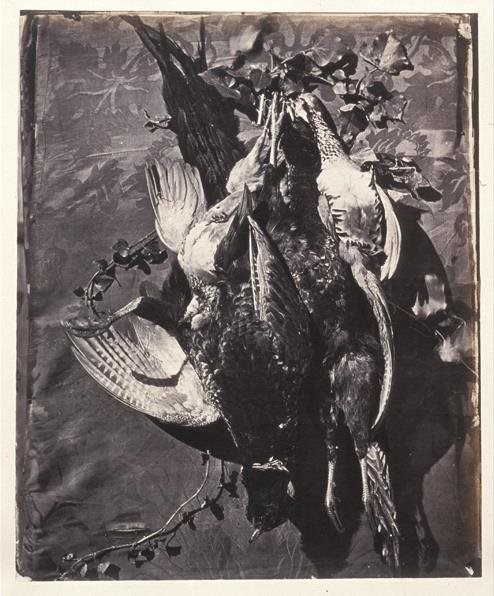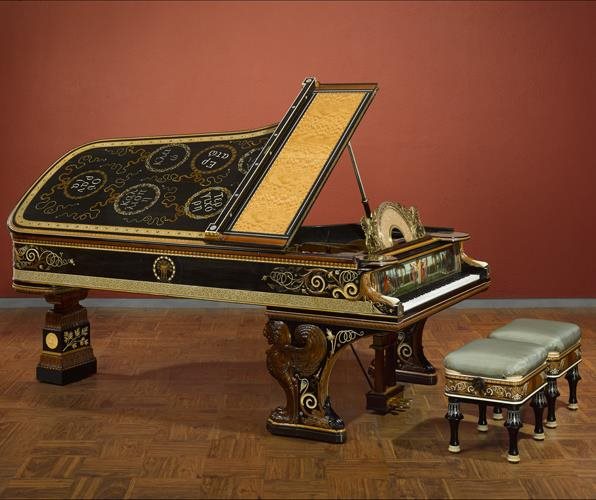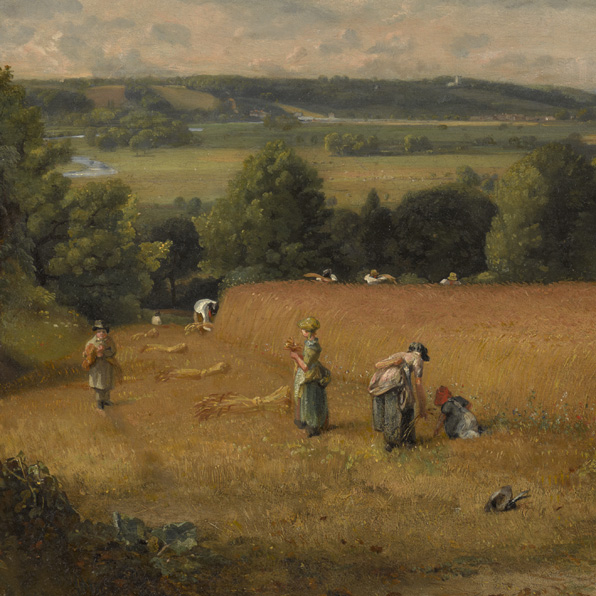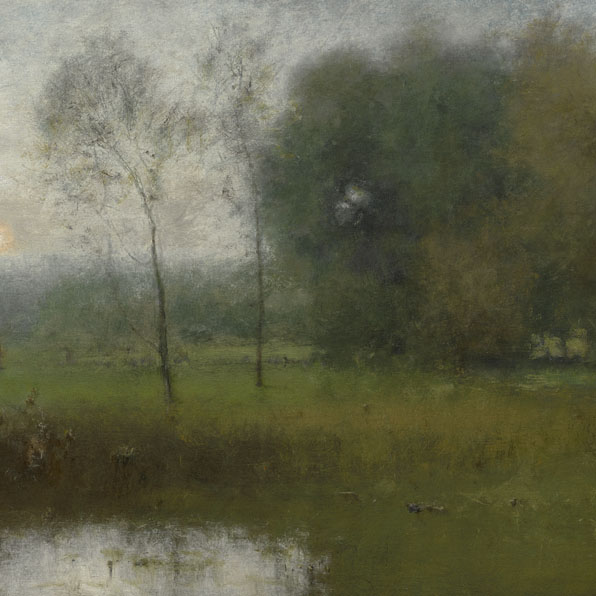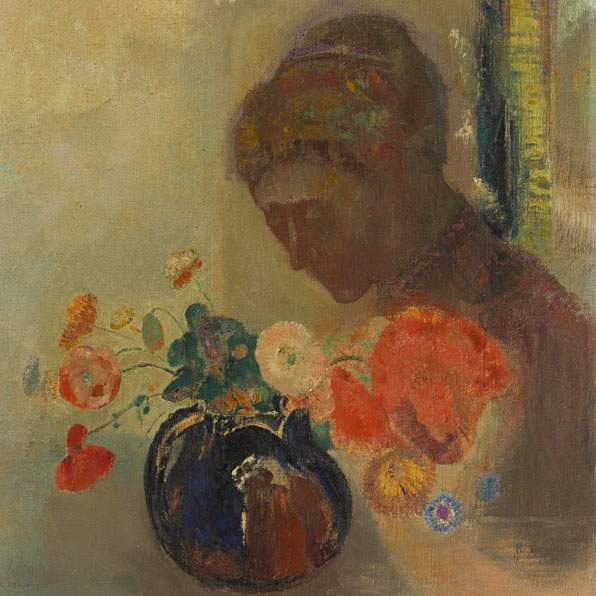
OCTOBER 25, 2015–APRIL 10, 2016
ACQUISITION HIGHLIGHTS
Jean-Baptiste Carpeaux
French, 1827–1875
Daphnis and Chloe (detail)
1874
Marble
Acquired by the Clark, 2013
2013.5
Strengthening the Clark’s collection of European sculpture through purchases and gifts has been a major initiative over the past twenty years. As a result, the Clark’s galleries are now enhanced by sculpture in marble, bronze, terracotta, and plaster. This important sculpture by Carpeaux is the latest addition to the sculpture initiative. Acquired in 2013 and unveiled with the reopening of the Museum Building in 2014, Carpeaux’s only marble version of this composition anchors the sculpture conservatory in the Museum Building, and adds richness and depth to the Clark’s nineteenth-century collections.
Daphnis caresses Chloe’s neck and tenderly leans toward her as if to whisper in her ear or brush her cheek with his lips. Carpeaux became famous for his dynamic sculptural compositions, which some of his contemporaries considered indecent. The sculptor treated this antique subject with grace and elegance, giving life to the young pair.
Erich Heckel
German, 1883–1970
Portrait of a Man (detail)
1918
Color woodcut, over zincograph, in green, blue, ochre, and black on paper
Acquired by the Clark, 2012
2012.7
This powerful woodcut was acquired as part of the Clark's recent initiative to collect German Expressionist prints. Portrait of a Man is the first work by the artist Erich Heckel to enter the collection and is generally considered a self-portrait. Heckel and his contemporaries often used portraiture as a means to explore inner emotions.
Giovanni Benedetto Castiglione
Italian, 1609–1664
Crucifixion with the Virgin, Saints John and Mary Magdalene, and God the Father (detail)
c. 1651
Brush and oil paint on paper
Acquired by the Clark, 2003
2003.9.15
In 2003, the Clark purchased thirty old master drawings from the John and Alice Steiner Collection, whose Renaissance and Baroque holdings were highly regarded. This important acquisition added depth and variety to the institute’s collection of drawings, which at the time focused mainly of nineteenth-century works. Today the Steiner Collection, including this drawing by Castiglione, forms a crucial part of the Clark’s works on paper collection.
Cavaliere d'Arpino (Giuseppe Cesari)
Italian, 1568–1640
Perseus Rescuing Andromeda (detail)
1594/95
Oil on panel
Acquired by the Clark, 2010
2010.7
Beginning in 2010, the Clark began to actively acquire small, sixteenth- and seventeenth-century cabinet pictures by Italian, French, and Flemish artists. Cabinet pictures are small paintings usually made for private collections and often characterized by a high degree of detail and refinement.
The former owner of this painting, a European private collector, let Clark curators know he was considering selling it several years before he finally made the decision to do so. Periodic conversations with the collector ensured that he knew of the Clark’s keen interest, and he eventually sold it to the Clark in 2010.
Employing minute brushwork and delicate glazes to create an enamel-like surface, the artist portrays the dramatic rescue of Andromeda by Perseus. The result is an intimate painting that was most likely originally intended for a private collector.
Johann Erhard Heuglin II
German, active 1717–1757
Meissen Porcelain Manufactory
1710-present
Additional German artisans
Breakfast Set (detail)
Augsburg, c. 1728–29
Gilded silver, hard-paste porcelain, glass, and velvet-lined leather case
Acquired by the Clark, 2012
2012.4
A highlight of the decorative arts collection, this breakfast set was purchased to complement and strengthen the Clark’s extensive collections of English and Continental silver and European porcelain.
Breakfast sets were often part of an aristocrat’s levee, a social ritual during which men or women would receive visitors as they ate and dressed. This set includes chocolate beakers, a tea service, cutlery, an egg cup, and bowls for bouillon. The exquisitely crafted items, made from gilded silver, etched glass, and Meissen porcelain, fit into custom made cavities within the original velvet-lined leather box. The box was designed so that, when opened, its contents could be viewed in a spectacular display.
Jacques Louis David
French, 1748–1825
Comte Henri-Amédée-Mercure de Turenne-d'Aynac (detail)
1816
Oil on canvas
Acquired by the Clark, 1999
1999.2
The painting descended from the sitter’s family until 1999, when it was purchased by the Clark as an outstanding example of early nineteenth-century heroic French portraiture.
The comte de Turenne is portrayed wearing a uniform and medals, which record his distinguished service in the French army. Both the sitter and the artist were closely associated with Napoleon, who had been defeated in Waterloo in 1815, a year before this portrait was painted. By 1816, both the count and David were living in exile in Brussels.
Bartolomeo Pinelli
Italian, 1781–1835
Juno Swears to Avenge the Death of Almo and Galaesus (detail)
1812
Pen and brown and gray ink and brush and brown and gray wash, over black chalk, heightened with white, on paper
Acquired by the Clark, 2009
2009.7.1
A Clark curator spotted this drawing and its pendant at the Master Drawings London art fair in 2009 and quickly made arrangements to have them brought to the Clark for purchase consideration. Remarkable in their quality and scale the drawings depict scenes of heroic deaths from Greek mythology. Juno Swears to Avenge the Death of Almo and Galesus tells the story of Juno’s revenge against the Phrygians from Virgil’s Aeneid. Juno’s anger precipitates a war between the Latins and Phrygians, its ensuing violence reflected in the deaths of the young Almo and the elderly Galaesus. Held in a private Scottish collection for generations, this drawing is in superb condition, having been displayed infrequently.
Charles Nègre
French, 1820–1880
Still Life with Game (detail)
c. 1855
Albumen print from wet collodion on glass negative
Acquired by the Clark, 2002
2002.7.4
In 1998, the Clark launched an initiative to collect nineteenth and early twentieth-century photographs to complement its core collection of paintings, works on paper, and decorative arts. The Clark’s collection of photographs has grown exponentially, now numbering nearly one thousand objects. This large still-life of game birds and ivy tendrils by Charles Nègre shows the artist’s penchant for dramatic light effects; he places the birds in bright sunlight against a patterned fabric background.
Designed by Sir Lawrence Alma-Tadema
(British, born Netherlands, 1836–1912)
Fallboard painted by Sir Edward John Poynter (British, 1836–1919)
Casework manufactured by Johnstone, Norman & Co., London
Action by Steinway & Sons, New York
Model D Pianoforte and Stools (detail)
1884–87
Oak, ebony, sandalwood, cedar, boxwood, ivory, coral, mother of pearl, copper, brass, pewter, and parchment
Acquired by the Clark, 1997
1997.8
When director Michael Conforti learned that this piano was to be auctioned at Christie’s, London, he immediately contacted the Clark’s trustees for approval to bid on it. Having long known the piece through private collectors, he felt strongly that the superbly crafted piano and stools would anchor the nineteenth-century academic paintings gallery, complementing the Alma-Tadema paintings of classical subjects in the collection as well as the Clark’s silver and porcelain. Although competition was intense, the Clark ended up with the winning bid.
The elaborate instrument was made for financier and philanthropist Henry Gurdon Marquand and was the centerpiece of the music room in his New York mansion.
John Constable
English, 1776–1837
The Wheat Field (detail)
1816
Oil on canvas
Gift of the Manton Art Foundation in memory of Sir Edwin and Lady Manton, 2007
2007.8.27
In 2007 the Clark received a gift of over three hundred paintings, drawings, and prints that now comprise the Manton Collection of British Art. This gift is one of the most significant and transformative acquisitions of art by the Clark since its founding in 1955. Sir Edwin A. G. Manton and his wife, Florence, Lady Manton, began collecting British art in the late 1940s. Hailing from England himself, Manton was based in New York where he was a driving force in the creation of American International Group Inc. (AIG). His interest in collecting British art was fueled by a deep nostalgia that he had for his home country. The Manton Collection includes numerous landscape paintings and oil studies by John Constable, such as this finished painting.
“I live almost wholly in the fields and see nobody but the harvest men,” wrote Constable to his fiancée in August 1815. That summer, working primarily outdoors, he painted The Wheat Field, a view across a valley in his native Suffolk. Plowmen cut down the golden wheat, reapers bundle the stalks, and gleaners collect leftover grains, while a boy and his dog guard lunch. The figures seem to be a natural part of the landscape, captured at a specific moment in time. Yet the artist carefully organized each element of the composition to craft an idyllic harvest scene.
George Inness
American, 1825–1894
New Jersey Landscape (detail)
1891
Oil on canvas
Gift of Frank and Katherine Martucci, 2013
2013.1.7
In 2013, Frank and Katherine Martucci of New York gave sixteen works of art to the Clark. Among these works were eight landscapes by American painter George Inness. The Martucci gift creates an impressive collection of works by this painter, complementing two Inness landscapes acquired by Sterling and Francine Clark in 1946 and 1955.
Although New Jersey Landscape may represent a specific place, the artist was less interested in defining recognizable details than in conveying nature’s immaterial essence, here expressed in finely modulated colors that have been painted with a brush and then wiped with a cloth so that they blend together without contours.
Georg Andreas Steinhauser
German, b. 1779
Looking Glass (detail)
Bremen, Germany, c. 1820–35
Carved and gilded wood, mirrored glass
Gift of Mr. and Mrs. Robert W. Chambers, Jr., 1997
1997.10.2
This looking glass was acquired by George Alfred Cluett and published in Luke Vincent Lockwood’s 1926 edition of Colonial Furniture of America as an example of an American mirror. The motif of the cornucopia, a symbol of prosperity, was popular in the early nineteenth century. Recent conservation treatment revealed a long-hidden, original label from the fabricator—a furniture maker based in Bremen, Germany. The looking glass was probably made for export to the United States, where at some point the evidence of its foreign origin was deliberately concealed.
George Cluett was born to a Troy, New York, family and became president of Cluett, Peabody & Co. Inc., a collar and shirt manufacturer based there. Cluett, who owned a summer house in Williamstown (now the Pine Cobble School), created a well-respected collection of American furniture and clocks. His daughter Florence Cluett Chambers inherited portions of this collection. She and her husband Robert gave several pieces to the Clark in the late 1990s, and more objects came to the Clark as a gift from her estate in 2001.
Odilon Redon
French, 1840–1916
Woman with a Vase of Flowers (detail)
c. 1903
Oil on canvas
Gift of Heinrich A. Medicus, 2014
2014.7
The Clark acquired this work when Dr. Heinrich Medicus, whose family owned the painting since 1930, offered it as a gift. The painting makes a significant addition to the Clark’s modest holdings in Post-Impressionist French painting.
Woman with a Vase of Flowers is characteristic of Redon’s late work, when he focused on vibrant flowers juxtaposed with disembodied heads. A key figure in the French Symbolist movement, Redon drew on mythological, biblical, and literary themes as well as on nature, all filtered through his visionary imagination to create hallucinatory images of astonishing strangeness.
Félix Thiollier
French, 1842–1914
Factory at Saint Étienne (detail)
c. 1900–1914
Gelatin silver print
Acquired by the Clark, 2007
2007.15.2
In 2007 the Clark was offered a unique opportunity by the descendants of the artist to acquire a group of eleven photographs by the then little-known photographer Félix Thiollier. A successful businessman in the textile industry in the Loire Valley, Thiollier first took up photography as a hobby in the 1860s. By the end of his life, he had produced thousands of photographs, which he neither sold nor exhibited. Despite his amateur status, his oeuvre reflects an awareness of international trends in contemporary photography.
Concept by Jonathan Monk
British, b. 1969
Designed by OK–RM, London
The Billboard Book Project (London) (detail)
Twenty royal sheets mounted with wood frame, twenty loose royal sheets and bound book
Paris: ©Three Star Books, 2012
Acquired by the Clark Art Institute Library, 2012
The Clark Art Institute Library began collecting artists’ books in 1976. The library has worked closely with the New York City-based Franklin Furnace Archive of artists’ books and Printed Matter Inc., a publisher and distributer of artists’ books, to expand the collection over several decades. The Clark’s artists’ books collection numbers 4,825 volumes today.
In Jonathan Monk’s work, the billboard is composed of twenty large-scale, so-called “royal”-sized sheets. Another copy of these sheets was folded and cut to produce the book displayed in this case. Five versions of the book, in increasingly smaller sizes, were issued by the publisher, demonstrating the process of printing and book binding. This copy is the “Royal Quarto” size, the second largest. In bookbinding, “quarto” refers to four leaves made from one original sheet, made possible by folding the sheet twice.


